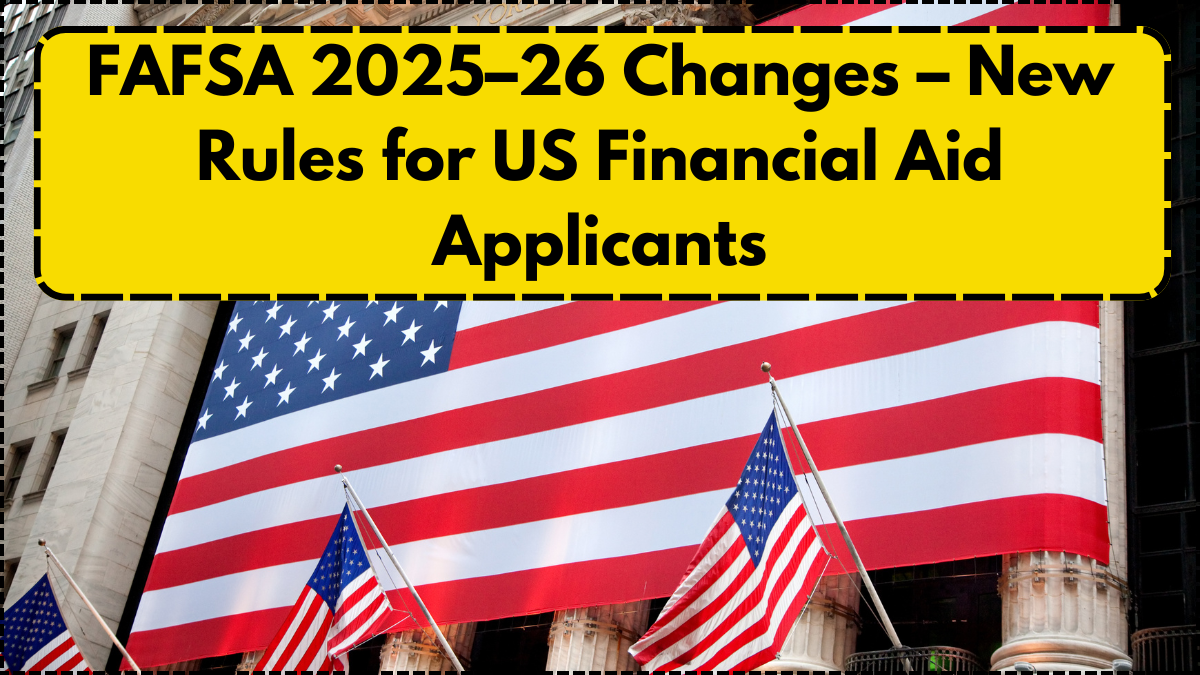Understanding the FAFSA Changes for 2025–26 is essential for every student and parent navigating college financial planning. The U.S. Department of Education has introduced significant modifications to the Free Application for Federal Student Aid (FAFSA) process, aiming to make federal aid more accessible and transparent. The newly implemented aid calculation & form update will influence how millions of students qualify for grants, loans, and scholarships in the upcoming academic year.
This article breaks down these changes in detail, highlights the new structure of the form, and helps applicants adapt to the new policies for the 2025–26 cycle.

Why the FAFSA Was Updated
The FAFSA Simplification Act, passed by Congress, is part of a broader initiative to streamline the financial aid process. The 2025–26 version includes:
-
Fewer questions on the form
-
Modified income and family contribution calculations
-
Better access for low-income families
-
Enhanced coordination with IRS data retrieval systems
These updates were implemented to reduce confusion and make financial aid fairer and more inclusive for all U.S. students.
Key FAFSA Changes for 2025–26
Here’s a summary of the most critical updates to the FAFSA process:
| Change | Previous Process | New Process 2025–26 |
|---|---|---|
| EFC replaced by SAI | Expected Family Contribution (EFC) | Student Aid Index (SAI) now used |
| IRS data transfer | Manual entry of tax details | Direct IRS data sync for accuracy |
| Number of questions | Over 100 questions | Reduced to fewer than 40 |
| Family size considerations | More complex calculations | Aligned with tax data for simplicity |
| Pell Grant eligibility | Dependent on EFC & formulas | Tied more closely to family income |
The goal of these aid calculation & form updates is to allow students to get clearer estimates of how much financial aid they may receive.
Student Aid Index (SAI) – A New Approach to Aid
One of the biggest shifts in the FAFSA Changes for 2025–26 is the replacement of the Expected Family Contribution (EFC) with the Student Aid Index (SAI).
What this means:
-
The SAI can now be a negative number, showing extreme financial need
-
Pell Grant eligibility is more predictable, based on family income and household size
-
SAI gives a clearer picture of need-based aid eligibility
The move to SAI aims to better reflect a student’s actual financial situation and eligibility.
Who Benefits from the FAFSA Form Update?
The new FAFSA format is expected to benefit:
-
Low-income families: With easier Pell Grant access
-
First-generation students: Simplified process removes technical barriers
-
Students from single-parent households: Form now supports simplified data entry
-
Students with complex family situations: Improved flexibility in income reporting
The FAFSA’s 2025–26 update focuses on equity and access for students who previously struggled with the complexity of the process.
Important Dates and Deadlines for FAFSA 2025–26
It’s essential for students to stay on top of their FAFSA filing to maximize aid eligibility. Here’s a timeline to follow:
| Activity | Date |
|---|---|
| FAFSA Form Opens | October 1, 2024 |
| Priority Filing Deadline | January 15, 2025 (varies by state) |
| Final Submission Deadline | June 30, 2025 |
| College Financial Aid Awards | Rolling basis after form submission |
Students are encouraged to apply as early as possible, as some financial aid is offered on a first-come, first-served basis.
Conclusion
The FAFSA Changes for 2025–26 bring clarity and simplicity to a process that has historically been difficult for many families. With the new aid calculation & form update, students now have a more user-friendly path to securing federal financial aid. By understanding these changes and preparing early, applicants can take full advantage of the opportunities provided for the 2025–26 academic year.
FAQs
What is the biggest change in FAFSA for 2025–26?
The major change is the replacement of the Expected Family Contribution (EFC) with the Student Aid Index (SAI), which better reflects financial need.
How many questions are there in the new FAFSA form?
The form has been simplified to fewer than 40 questions, making it much easier to complete.
Can Pell Grant eligibility be estimated with the new form?
Yes, Pell Grant eligibility is now more predictable based on income thresholds and family size.
Is the IRS Data Retrieval Tool still used?
Yes, but it’s now more integrated. IRS data is transferred directly for accuracy and convenience.
When should I submit my FAFSA for 2025–26?
The form opens on October 1, 2024, and early submission is highly recommended for priority aid consideration.
Click here to learn more